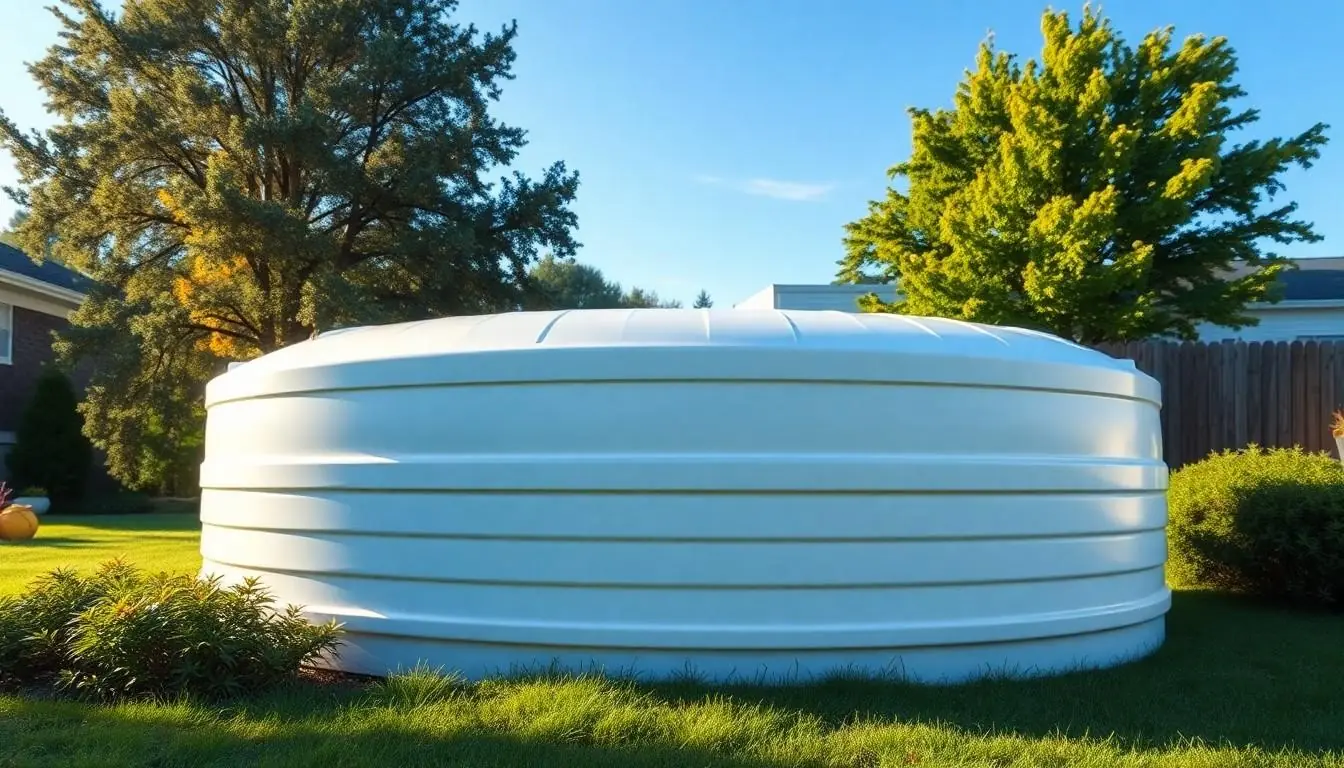In a world where a sudden drought can turn your garden into a desert faster than you can say “water, please,” having a home water storage tank is like having a superhero in your backyard. These tanks aren’t just big containers; they’re your reliable sidekicks in the battle against water shortages and skyrocketing utility bills. Imagine a life where you can water your plants, wash your car, and even fill your kiddie pool without breaking the bank. Sounds dreamy, right?
But wait, there’s more! Investing in a home water storage tank not only saves you money but also helps you become the eco-friendly hero your neighborhood didn’t know it needed. So, whether you’re preparing for the next big storm or just want to make sure your family stays hydrated, let’s dive into the world of home water storage tanks and discover how they can transform your household into a water-saving oasis.
Table of Contents
ToggleOverview of Home Water Storage Tanks
Home water storage tanks serve as vital resources for homeowners seeking reliable water access. These tanks store water for various uses, from irrigation to daily household tasks. Utility bills decrease significantly as water from these tanks often comes from rain or well sources instead of municipal supplies.
Various types of tanks exist on the market, including above-ground and underground options. Above-ground tanks offer easier installation and maintenance, while underground tanks save space and protect water from temperature fluctuations. Material options range from plastic to steel, ensuring durability for different environmental conditions.
Homeowners benefit from sizes ranging from 50 to 10,000 gallons, allowing customization according to specific needs. Proper installation boosts efficiency and can increase the lifespan of the system. Maintenance demands include routine checks for leaks, cleaning, and ensuring proper filtration systems are in place.
The environmental advantages of having a home water storage tank amplify water conservation efforts. Rainwater harvesting becomes an effective strategy to collect and store water during rainy seasons. Using stored water for irrigation promotes sustainability while reducing dependence on municipal sources.
Many local regulations influence the installation and use of home water storage tanks. Homeowners should check with local authorities to ensure compliance. Understanding these regulations ensures that the benefits of storage tanks are fully realized without legal complications.
Types of Home Water Storage Tanks

Home water storage tanks come in various types, each serving unique purposes and situations. These tanks can optimize water use efficiently and effectively.
Above Ground Tanks
Above ground tanks are easy to install and frequently made from materials like polyethylene or fiberglass. Owners appreciate their mobility since these tanks can be relocated. Common sizes range from 50 to 10,000 gallons, accommodating different household needs. These tanks often serve as storage for rainwater, irrigation, or even emergency water supply. Preventive maintenance ensures longevity, and regular checks for leaks or damage are crucial.
Below Ground Tanks
Below ground tanks enhance aesthetics by keeping storage hidden while providing ample space. Made from concrete, fiberglass, or polyethylene, they resist environmental elements effectively. Commonly sized from 500 to 5,000 gallons, below ground tanks efficiently store large volumes of water. Installation requires excavation, making it essential to follow local regulations and guidelines. Accessibility for maintenance remains important; proper planning ensures easy access for repairs or inspections.
Benefits of Using Home Water Storage Tanks
Home water storage tanks provide numerous advantages for households, enhancing convenience and sustainability. They serve as essential resources for managing water use effectively.
Emergency Preparedness
Emergency preparedness significantly benefits from home water storage tanks. They supply a reliable backup water source during natural disasters or supply disruptions. Residents can access stored water for drinking, cooking, and sanitation without relying on municipal systems. Many municipalities recommend at least one gallon of water per person per day for emergencies. Tanks with a capacity of 500 gallons can meet the needs of a family of four for about two months. Homeowners can mitigate risks associated with water scarcity by having a water storage system in place.
Water Conservation
Water conservation becomes more achievable with the installation of storage tanks. Collecting rainwater reduces reliance on local water supplies and minimizes water bills. Systems utilizing storage tanks often integrate rainwater harvesting methods, capturing runoff from roofs during rainfall. This practice can decrease annual water usage by up to 50%, benefiting both the environment and household finances. Homeowners contribute to ecological preservation while fostering sustainable practices through efficient water management. Effective use of storage tanks preserves vital resources for future generations.
Considerations When Choosing a Home Water Storage Tank
Selecting the right home water storage tank involves careful consideration of factors like capacity, size, material, and durability. Making an informed decision ensures effective water management.
Capacity and Size
Capacity affects how much water the tank can hold. Tanks come in various sizes, typically ranging from 50 to 10,000 gallons for above-ground models and from 500 to 5,000 gallons for underground options. Homeowners need to evaluate their water needs based on household consumption, irrigation requirements, and emergency preparedness. A 500-gallon tank generally supports a family of four for about two months. Space availability on property also plays a crucial role in determining the appropriate size. Checking local regulations may provide further guidance regarding allowable tank sizes.
Material and Durability
Material significantly impacts a tank’s durability and lifespan. Common materials include polyethylene, fiberglass, and concrete, each offering distinct advantages. Polyethylene tanks are lightweight and resistant to rust, while fiberglass tanks offer excellent durability in various conditions. Concrete tanks provide structural strength but involve more complex installation. Assessing the local climate can guide choices; for instance, tanks in freeze-prone areas must withstand low temperatures. Prioritizing quality materials ensures longevity and minimizes maintenance requirements over time.
Installation and Maintenance of Home Water Storage Tanks
Installation of home water storage tanks requires careful planning and adherence to local regulations. First, homeowners must select an appropriate location, considering accessibility and proximity to water sources. Ground leveling is crucial for stability, particularly for above-ground tanks. Digging is essential for underground tanks, often necessitating professional assistance to ensure proper installation.
After positioning the tank, connecting it to existing plumbing structures follows. Ensuring secure fittings and valves minimizes leaks and enhances performance. A filtration system may also be installed to maintain water quality, especially for rainwater harvesting.
Maintenance plays a significant role in extending the lifespan of water storage tanks. Periodic inspections are necessary to check for leaks, cracks, and signs of corrosion. Homeowners should clean tanks a minimum of once a year to prevent sediment buildup and other contaminants. Testing water quality regularly ensures it remains safe for consumption and use.
Maintaining the surrounding area is also important; keeping vegetation trimmed prevents overgrowth that might affect tank accessibility. Homeowners may consider installing a protective cover for above-ground tanks to shield them from debris and sunlight.
Finally, understanding the signs indicating maintenance needs is crucial. Unusual odors, discoloration, or fluctuating water pressure can signal problems. Addressing these issues promptly prevents costly repairs and ensures continued optimal performance.
Investing in a home water storage tank can transform how households manage their water needs. By providing a reliable source of water for various uses it not only enhances convenience but also promotes sustainability. Homeowners can enjoy significant savings on utility bills while contributing to environmental conservation efforts.
With the right tank in place maintenance becomes straightforward and efficient. This proactive approach ensures that families are prepared for emergencies and can make the most of rainwater harvesting. Ultimately choosing a water storage tank is a smart decision that benefits both the household and the planet.


